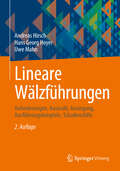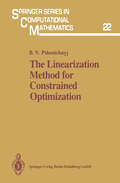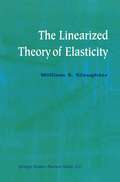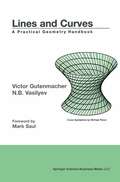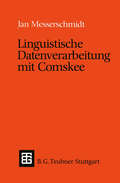- Table View
- List View
Lineare Optimierung (Mathematik für Ingenieure und Naturwissenschaftler, Ökonomen und Landwirte #14)
by Karl Manteuffel11 stellt die Gesamtbearbeitungszeit dar. Sie ist zu maximieren, um den Zeitfonds so gut wie möglich auszunutzen. Somit lautet das mathematische Modell der angegebenen AufgabensteIlung: Die lineare Zielfunktion ZF: (2.1) ist unter Berücksichtigung der folgenden Nebenbedingungen zu maximieren: NB: IOxl + 10x2 = [Xl' X ] = [700,0], 2 2. x~> = [Xl' X] = [0, 600], 2 3. x0> = [Xl' X2] = [300, 500], denn werden die Zahlenwerte für Xl und X in die Nebenbedingungen eingesetzt, so 2 sind diese erfüllt. Zu XCI): NB: 10·700 + 10·0 = 7000 O. ZF: Z(xC!» = 40·700 + 50·0 = 28000. Die benötigte Gesamtbearbeitungszeit beträgt also 28000 h, wenn 700 St. vom Werk stück EI und 0 St. vom Werkstück E2 bearbeitet werden. 12000 h werden bei diesem Produktionsprogramm vom Gesamtzeitfonds nicht genutzt. Gegenüber der Lösung X(l) ist die Lösung X(2) besser, da bei ihr nur 10000 h vom Gesamtzeitfonds ungenutzt bleiben, bzw. 30000 h genutzt werden. Die Lösung X(3) ist weit besser als die beiden vorhergehenden, da bei ihr nur noch 3000 h ungenutzt bleiben und 37000 h genutzt werden.
Lineare Optimierung – eine anwendungsorientierte Einführung in Operations Research: Mit Python-Programmen
by Andreas Koop Hardy MoockLeicht verständlich und praxisorientiert behandelt das vorliegende Buch die wesentlichsten Gebiete der Linearen Optimierung, einem Kernbereich des Operations Research. Es wendet sich an Studierende betriebswirtschaftlicher und technischer Disziplinen. Aber auch der Praktiker aus kleinen und mittelständischen Unternehmen wird in hohem Maße davon profitieren. Da kaum mathematische Kenntnisse vorausgesetzt werden, fällt es gerade ihm leicht, sich selbstständig in die Lineare Programmierung einzuarbeiten, die erhebliche Kostensenkungen und Zeiteinsparungen ermöglicht. Auch Studierende der Mathematik und der Informatik werden durch das Buch angesprochen, da sie sehr schnell einen Überblick über die Lineare Programmierung gewinnen können. Kurz und prägnant, dabei vollständig und mathematisch exakt, werden die Methoden hergeleitet, rezeptartig zusammengefasst, durch zahlreiche Beispiele und Übungsaufgaben ergänzt und mit zwei Fallstudien aus der betriebswirtschaftlichen und technischen Praxis angereichert. Nicht zu vergessen die softwaretechnische Umsetzung der Linearen Programme mittels Excel-Solver bzw. der Programmiersprache C. Dieses Buch ist ein Muss für jeden, der in die Thematik der Linearen Optimierung einsteigen möchte.
Lineare Regelungs- und Steuerungstheorie
by Kurt ReinschkeDer Leser wird befähigt, die mathematischen Werkzeuge der linearen Systemtheorie für regelungstechnische Zwecke einzusetzen. Im Zentrum stehen die funktionentheoretischen und algebraischen Zusammenhänge, die sowohl Trajektoriensteuerungen als auch den Entwurf robuster stabilisierender Regler sowie die zeitkontinuierliche Behandlung von Abtastregelkreisen ermöglichen. Zahlreiche Beispiele illustrieren die Anwendung der allgemeinen Gesetzmäßigkeiten. Bei der Modellierung von Regelstrecken werden die unvermeidlichen Unbestimmtheiten berücksichtigt. Das Werk liegt nun in der zweiten, vollständig überarbeiteten und neu strukturierten Fassung vor, die inhaltlich um neue Forschungsergebnisse zum Entwurf von Steuerungen und Reglern erweitert wurde.
Lineare Regelungs- und Steuerungstheorie: Modellierung von Regelstrecken, Robuste Stabilität und Entwurf robuster Regler, Trajektoriensteuerung mit Folgeregelung, Polynomiale Beschreibung von MIMO-Systemen, Zeitdiskrete und Abtastregelkreise
by Kurt ReinschkeDer Autor wendet sich an Leser, die eine gute mathematische Vorbildung und eine anwendungsorientierte Grundausbildung in Regelungs- und Steuerungstechnik abgeschlossen haben und nun tiefer in die Methoden der Regelung und Steuerung von linearen zeitkontinuierlichen Prozessen eindringen wollen. Der Leser wird befähigt, die mathematischen Werkzeuge der linearen Systemtheorie für regelungstechnische Zwecke einzusetzen.
Lineare Systeme und Netzwerke: Eine Einführung (Hochschultext)
by Hellmuth WolfLineare Systeme und Netzwerke ist ein vorlesungsbegleitendes Lehrbuch für Studenten der Elektrotechnik und verwandter Fachgebiete. Vorausgesetzt werden Kenntnisse der elementaren Grundlagen der Elektrotechnik. Die mathematischen Voraussetzungen entsprechen dem Ausbildungsstand der Studenten der Elektrotechnik im fünften Semester an wissenschaftlichen Hochschulen. Das Lehrbuch gibt einen nach didaktischen Gesichtspunkten aufgebauten Überblick der Netzwerktheorie im Rahmen der allgemeinen Theorie linearer Systeme und bemüht sich um Plausibilität, sinnvolle Reihenfolge, Hinweise auf Zusammenhänge und anschauliche Beispiele; auf strenge Beweisführung wird verzichtet. Zusammenfassungen, Übersichten und Tabellen erleichtern die Anwendung der Theorie und ermöglichen eine rasche Wiederholung des Stoffes. Das Buch hat sich seit mehr als einem Jahrzehnt auch im Selbststudium bewährt.
Lineare und nichtlineare FEM: Eine Einführung mit Anwendungen in der Umformsimulation mit LS-DYNA®
by Marcus WagnerDieses Lehrbuch bringt im ersten Teil leicht verständlich die Merkmale und Eigenschaften linearer finiter Elemente aus dem Bereich der Elastostatik und Dynamik und erläutert Vorgehensweisen bei der Erstellung von Simulationsmodellen. Im zweiten Teil liegt der Schwerpunkt auf nichtlinearen zeitabhängigen Vorgängen und Lösungsverfahren. Praxisbeispiele aus der Umformtechnik werden anschaulich mit der Software LS-DYNA gelöst. Der Fokus liegt auf einer Erklärung der Zusammenhänge, die für Anwender kommerzieller Software notwendig sind. Theoretische Grundlagen werden in dem Umfang dargestellt, der für das Verständnis der Benutzung eines Programms notwendig ist.
Lineare und nichtlineare FEM: Eine Einführung mit Anwendungen in der Umformsimulation mit LS-DYNA®
by Marcus WagnerDieses Lehrbuch bringt im ersten Teil leicht verständlich die Merkmale und Eigenschaften linearer finiter Elemente aus dem Bereich der Elastostatik und Dynamik und erläutert Vorgehensweisen bei der Erstellung von Simulationsmodellen. Im zweiten Teil liegt der Schwerpunkt auf nichtlinearen zeitabhängigen Vorgängen und Lösungsverfahren. Praxisbeispiele aus der Umformtechnik werden anschaulich mit der Software LS-DYNA gelöst. Der Fokus liegt auf einer Erklärung der Zusammenhänge, die für Anwender kommerzieller Software notwendig sind. Theoretische Grundlagen werden in dem Umfang dargestellt, der für das Verständnis der Benutzung eines Programms notwendig ist. Die 2. Auflage wurde um weitere Übungsaufgaben ergänzt und die Musterlösungen aller Aufgaben wurden stark erweitert. Die Bildqualität und -darstellung wurde deutlich verbessert.
Lineare und nichtlineare FEM: Eine Einführung mit Anwendungen in der Umformsimulation mit LS-DYNA®
by Marcus WagnerDieses Lehrbuch bringt im ersten Teil leicht verständlich die Merkmale und Eigenschaften linearer finiter Elemente aus dem Bereich der Elastostatik und Dynamik und erläutert Vorgehensweisen bei der Erstellung von Simulationsmodellen. Im zweiten Teil liegt der Schwerpunkt auf nichtlinearen zeitabhängigen Vorgängen und Lösungsverfahren. Praxisbeispiele aus der Umformtechnik werden anschaulich mit der Software LS-DYNA® gelöst. Der Fokus liegt auf einer Erklärung der Zusammenhänge, die für Anwender kommerzieller Software notwendig sind. Theoretische Grundlagen werden in dem Umfang dargestellt, der für das Verständnis der Benutzung eines Programms notwendig ist. Die vorliegende Auflage wurde stark überarbeitet und die Anzahl der Übungsaufgaben mit Lösungen wurde erhöht.
Lineare und nichtlineare Schwingungen und Wellen (Teubner Studienbücher Physik)
by Damien Philippe ScherrerLineare Wälzführungen: Anforderungen, Auswahl, Auslegung, Ausführungsbeispiele, Schadensfälle
by Andreas Hirsch Hans Georg Hoyer Uwe MahnDieses Fachbuch stellt anschaulich und praxisnah das aktuelle Ingenieurwissen zu Anforderungen, Aufbau, Funktionsweise und Auslegung linearer Wälzführungen beim Einsatz in Werkzeugmaschinen dar. Es werden ausführlich die Wirkmechanismen, deren konstruktive Umsetzung und Möglichkeiten zur Berechnung behandelt. Entsprechend dem Einsatz der Führungssysteme werden in der Praxis bewährte Lösungen gezeigt und Schadensfälle analysiert. Das Buch wendet sich an Ingenieure, die sich mit der Auslegung und Beurteilung linearer Wälzführungen täglich beschäftigen. Aber auch Monteure und Maschinenanwender dient es als zuverlässiger Ratgeber. Es ist ein hilfreiches Nachschlagewerk für Maschinenentwickler und bei der Gestaltung von genauigkeitsbestimmenden Führungen in Werkzeugmaschinen, aber auch von zuverlässigen Führungen für Positionier- und Transportaufgaben.
Lineare Wälzführungen: Anforderungen, Auswahl, Auslegung, Ausführungsbeispiele, Schadensfälle
by Andreas Hirsch Hans Georg Hoyer Uwe MahnDieses Fachbuch stellt anschaulich und praxisnah das aktuelle Ingenieurwissen zu Anforderungen, Aufbau, Funktionsweise und Auslegung linearer Wälzführungen im Bereich des Maschinenbaus dar. Dabei wird die Vielfalt möglicher Ausführungen mit ihren Einsatzmöglichkeiten vorgestellt. Es werden ausführlich die Wirkmechanismen, deren konstruktive Umsetzung und die Berechnung zur Auslegung solcher Systeme behandelt. In der Praxis bewährte Lösungen sowie aufgetretene Schadensfälle werden aufgezeigt und analysiert. Das Buch ist ein hilfreiches Nachschlagewerk und unterstützt bei der Auswahl, Auslegung und Beurteilung linearer Wälzführungen. Es dient als zuverlässiger Ratgeber bei der Entwicklung von Maschinen, bei der Gestaltung von Führungen für Positionier- und Transportaufgaben sowie der Konstruktion von genauigkeitsbestimmenden Führungen in Werkzeugmaschinen. Die vorliegende Auflage wurde überarbeitet und Beispiele zur Auslegung und Berechnungen wurden neu eingefügt.
The Linearization Method for Constrained Optimization (Springer Series in Computational Mathematics #22)
by Boris N. PshenichnyjTechniques of optimization are applied in many problems in economics, automatic control, engineering, etc. and a wealth of literature is devoted to this subject. The first computer applications involved linear programming problems with simp- le structure and comparatively uncomplicated nonlinear pro- blems: These could be solved readily with the computational power of existing machines, more than 20 years ago. Problems of increasing size and nonlinear complexity made it necessa- ry to develop a complete new arsenal of methods for obtai- ning numerical results in a reasonable time. The lineariza- tion method is one of the fruits of this research of the last 20 years. It is closely related to Newton's method for solving systems of linear equations, to penalty function me- thods and to methods of nondifferentiable optimization. It requires the efficient solution of quadratic programming problems and this leads to a connection with conjugate gra- dient methods and variable metrics. This book, written by one of the leading specialists of optimization theory, sets out to provide - for a wide readership including engineers, economists and optimization specialists, from graduate student level on - a brief yet quite complete exposition of this most effective method of solution of optimization problems.
Linearization Methods for Stochastic Dynamic Systems (Lecture Notes in Physics #730)
by Leslaw SochaFor most cases of interest, exact solutions to nonlinear equations describing stochastic dynamical systems are not available. This book details the relatively simple and popular linearization techniques available, covering theory as well as application. It examines models with continuous external and parametric excitations, those that cover the majority of known approaches.
Linearization of Nonlinear Control Systems
by Hong-Gi LeeThis textbook helps graduate level student to understand easily the linearization of nonlinear control system. Differential geometry is essential to understand the linearization problems of the control nonlinear systems. In this book, the basics of differential geometry needed in linearization are explained on the Euclidean space instead of the manifold for students who are not accustomed to differential geometry. Many Lie algebra formulas, used often in linearization, are also provided with proof. The conditions in the linearization problems are complicated to check because the Lie bracket calculation of vector fields by hand needs much concentration and time. This book provides MATLAB programs for most of the theorems. The book also includes end-of-chapter problems and other pedagogical aids to help understanding and self study.
Linearized Analysis of One-Dimensional Magnetohydrodynamic Flows (Springer Tracts in Natural Philosophy #1)
by Roy M. GundersenMagnetohydrodynamics is concerned with the motion of electrically conducting fluids in the presence of electric or magnetic fields. Un fortunately, the subject has a rather poorly developed experimental basis and because of the difficulties inherent in carrying out controlled laboratory experiments, the theoretical developments, in large measure, have been concerned with finding solutions to rather idealized problems. This lack of experimental basis need not become, however, a multi megohm impedance in the line of progress in the development of a satisfactory scientific theory. While it is true that ultimately a scientific theory must agree with and, in actuality, predict physical phenomena with a reasonable degree of accuracy, such a theory must be sanctioned by its mathematical validity and consistency. Physical phenomena may be expressed precisely and quite comprehensively through the use of differential equations, and the equations formulated by LUNDQUIST and discussed by FRIEDRICHS belong to a class of equations particularly well-understood and extensively studied. This class includes, in fact, many other eminent members, the solutions of which have led to results of far-reaching scientific and technological application. Frequently, the mathematical analysis has provided the foundations and guidance necessary for further developments, and, reciprocally, the physical problems have provided, in many cases, the impetus for the development of new mathematical theories which often have evolved to an a priori unpredictable extent.
The Linearized Theory of Elasticity
by William S. SlaughterThis book is derived from notes used in teaching a first-year graduate-level course in elasticity in the Department of Mechanical Engineering at the University of Pittsburgh. This is a modern treatment of the linearized theory of elasticity, which is presented as a specialization of the general theory of continuum mechanics. It includes a comprehensive introduction to tensor analysis, a rigorous development of the governing field equations with an emphasis on recognizing the assumptions and approximations in herent in the linearized theory, specification of boundary conditions, and a survey of solution methods for important classes of problems. Two- and three-dimensional problems, torsion of noncircular cylinders, variational methods, and complex variable methods are covered. This book is intended as the text for a first-year graduate course in me chanical or civil engineering. Sufficient depth is provided such that the text can be used without a prerequisite course in continuum mechanics, and the material is presented in such a way as to prepare students for subsequent courses in nonlinear elasticity, inelasticity, and fracture mechanics. Alter natively, for a course that is preceded by a course in continuum mechanics, there is enough additional content for a full semester of linearized elasticity.
Lines and Curves: A Practical Geometry Handbook
by Victor Gutenmacher N.B. VasilyevBroad appeal to undergraduate teachers, students, and engineers; Concise descriptions of properties of basic planar curves from different perspectives; useful handbook for software engineers; A special chapter---"Geometry on the Web"---will further enhance the usefulness of this book as an informal tutorial resource.; Good mathematical notation, descriptions of properties of lines and curves, and the illustration of geometric concepts facilitate the design of computer graphics tools and computer animation.; Video game designers, for example, will find a clear discussion and illustration of hard-to-understand trajectory design concepts.; Good supplementary text for geometry courses at the undergraduate and advanced high school levels
The Lines of Torres Vedras 1809–11 (Fortress)
by Bill Younghusband Ian FletcherFollowing the battle of Bussaco on 27 September 1810 Wellington's heavily outnumbered troops began to withdraw towards Lisbon. By the evening of 9 October the British and Portuguese began to withdraw behind a line of defensive works that had been built to the north of Lisbon. These were not the rudimentary field works that the French anticipated, but an enormous network of forts, batteries and redoubts whose construction had been started the previous November the Lines of Torres Vedras. This 30-mile-wide line utilised the area's natural defences, damming rivers, scarping hillsides, blocking roads and establishing forts upon almost all of the hills. This title describes its design, creation and effectiveness in the face of French attacks.
The Lines of Torres Vedras 1809–11 (Fortress #7)
by Bill Younghusband Ian FletcherFollowing the battle of Bussaco on 27 September 1810 Wellington's heavily outnumbered troops began to withdraw towards Lisbon. By the evening of 9 October the British and Portuguese began to withdraw behind a line of defensive works that had been built to the north of Lisbon. These were not the rudimentary field works that the French anticipated, but an enormous network of forts, batteries and redoubts whose construction had been started the previous November the Lines of Torres Vedras. This 30-mile-wide line utilised the area's natural defences, damming rivers, scarping hillsides, blocking roads and establishing forts upon almost all of the hills. This title describes its design, creation and effectiveness in the face of French attacks.
Linguistic Fuzzy Logic Methods in Social Sciences (Studies in Fuzziness and Soft Computing #253)
by Badredine ArfiThe modern origin of fuzzy sets, fuzzy algebra, fuzzy decision making, and “computing with words” is conventionally traced to Lotfi Zadeh’s publication in 1965 of his path-breaking refutation of binary set theory. In a sixteen-page article, modestly titled “Fuzzy Sets” and published in the journal Information and Control, Zadeh launched a multi-disciplinary revolution. The start was relatively slow, but momentum gathered quickly. From 1970 to 1979 there were about 500 journal publications with the word fuzzy in the title; from 2000 to 2009 there were more than 35,000. At present, citations to Zadeh’s publications are running at a rate of about 1,500-2,000 per year, and this rate continues to rise. Almost all applications of Zadeh’s ideas have been in highly technical scientific fields, not in the social sciences. Zadeh was surprised by this development. In a personal note he states: “When I wrote my l965 paper, I expected that fuzzy set theory would be applied primarily in the realm of human sciences. Contrary to my expectation, fuzzy set theory and fuzzy logic are applied in the main in physical and engineering sciences.” In fact, the first comprehensive examination of fuzzy sets by a social scientist did not appear until 1987, a full twenty-two years after the publication of Zadeh’s seminal article, when Michael Smithson, an Australian psychologist, published Fuzzy Set Analysis for Behavioral and Social Sciences.
Linguistic Methods Under Fuzzy Information in System Safety and Reliability Analysis (Studies in Fuzziness and Soft Computing #414)
by Mohammad YazdiThis book reviews and presents a number of approaches to Fuzzy-based system safety and reliability assessment. For each proposed approach, it provides case studies demonstrating their applicability, which will enable readers to implement them into their own risk analysis process.The book begins by giving a review of using linguistic terms in system safety and reliability analysis methods and their extension by fuzzy sets. It then progresses in a logical fashion, dedicating a chapter to each approach, including the 2-tuple fuzzy-based linguistic term set approach, fuzzy bow-tie analysis, optimizing the allocation of risk control measures using fuzzy MCDM approach, fuzzy sets theory and human reliability, and emergency decision making fuzzy-expert aided disaster management system.This book will be of interest to professionals and researchers working in the field of system safety and reliability, as well as postgraduate and undergraduate students studying applications of fuzzy systems.
Linguistische Datenverarbeitung mit Comskee (XTeubner Studienbücher Informatik)
by Jan MesserschmidtThe Lingzhi Mushroom Genome (Compendium of Plant Genomes)
by Chang LiuThis book becomes an invaluable reference on the genetic resources, genome, genes, chemical compounds, and their therapeutic effects for the Lingzhi mushrooms. It is the first comprehensive compilation of genetic resources, nuclear genome, mitochondrial genome, genes, noncoding RNAs, such as long intergenic noncoding RNAs, microRNAs, circular RNAs, genes in the biosynthetic pathway, chemical compounds and their therapeutic effects, transformation system for the expression of key genes, a bibliometric analysis to identify the past research work and the future research direction, and a survey of products derived from the Lingzhi mushrooms. Each chapter of this book is written by authors of globally reputed experts on the relevant field who had published high-quality articles in the corresponding subject. The book has 12 chapters and each chapter has a length of approximately ten thousand words, including ten items (tables or figures), about 30–50 references. This book is useful to the students, teachers, and scientists in academia and relevant private companies interested in horticulture, genetics, physiology, molecular genetics, and breeding, in vitro culture and genetic engineering, and structural and functional genomics. This book is also useful to seed and pharmaceutical industries.












